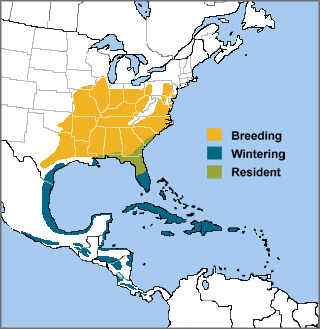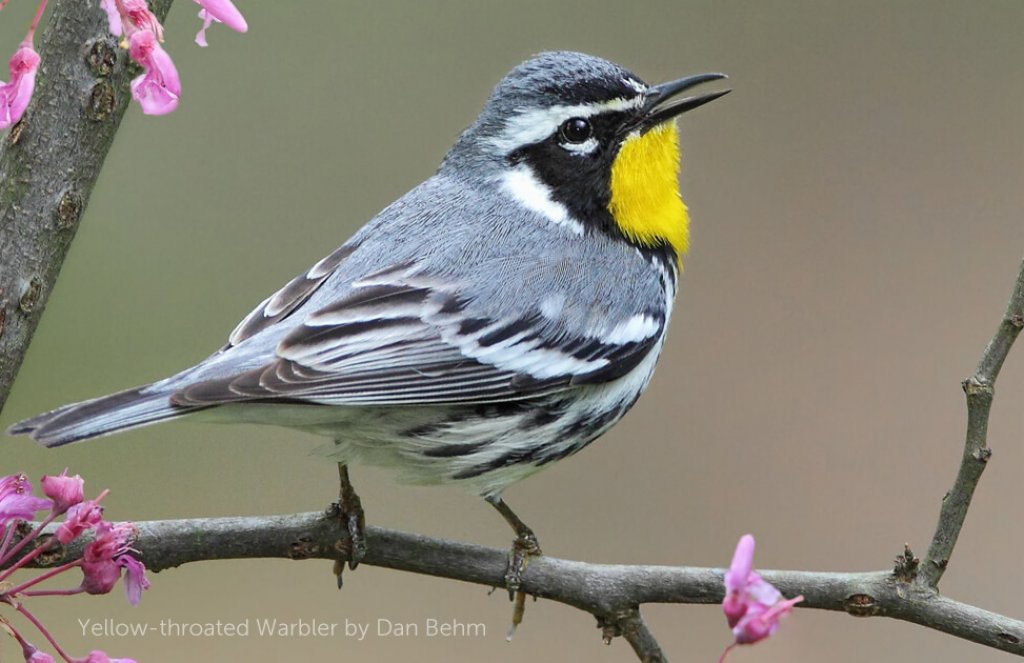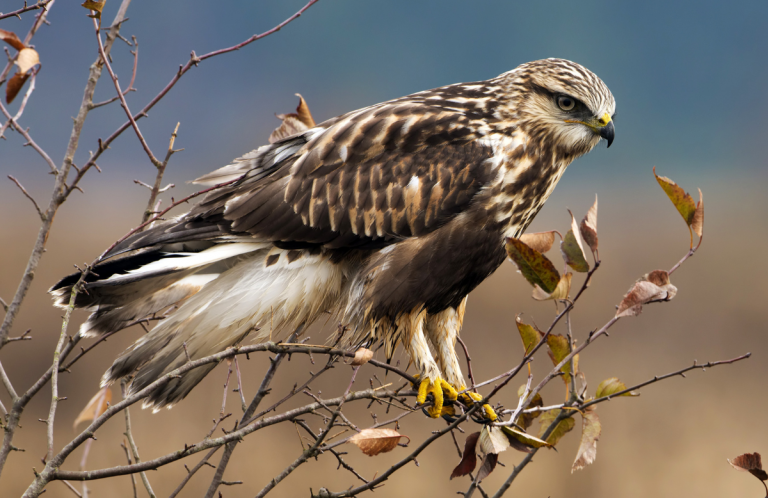
Yellow-throated Warbler range map by ABC
The striking plumage and sweet, downward-lilting song of the Yellow-throated Warbler are welcome signs of early spring in many parts of the southeastern United States. Arriving on its breeding grounds before most trees have fully leafed out, this attractive warbler stays high in the canopy. Once spotted, it can be identified easily by its bright yellow throat and chest framed in black, clean black-and-white facial pattern, and blue-gray back.
The Yellow-throated Warbler's species name is dominica because it was first described from the Caribbean island of Hispaniola, which includes the Dominican Republic. Although this bird belongs to the wood-warbler genus Setophaga, it differs from relatives such as the Yellow, Townsend's, and Black-throated Green Warblers in a number of ways.
A Family Standout
Although the Yellow-throated Warbler belongs to a group of highly migratory birds, it has a larger year-round (resident) population in the United States than do most other wood-warblers. (Only the Common Yellowthroat and Pine Warbler have larger year-round ranges, and the western “Audubon's” Yellow-rumped Warbler also occurs year-round in a number of regions.) Even Yellow-throated Warbler populations that migrate travel relatively short distances — those from the eastern part of the range move to the southern United States and Caribbean, while those from further west migrate to southern Texas and Central America.
The Yellow-throated Warbler also has a distinctive foraging style, moving methodically up and down tree limbs and trunks somewhat like a Brown Creeper or a Black-and-white Warbler while probing bark crevices, pine needles, and Spanish moss with its long, narrow bill. English naturalist Mark Catesby, one of the first to illustrate this warbler, described it as the "Yellow-throated Creeper." This bird sometimes hangs upside down in the manner of a White-breasted Nuthatch as it searches for insects, spiders, and their larvae, and, less commonly, will make short aerial dashes to catch insects in mid-air.
Pines, Palms, and Sycamores
The Yellow-throated Warbler nests in a variety of southern forest types, ranging from upland pine stands to sycamore-lined riparian corridors, and lowland swamps of bald cypress and live oak festooned with Spanish moss. Its breeding range once reached northward as far as southern Michigan, but contracted in the later 19th and early 20th centuries. After 1940, Yellow-throated Warbler breeding populations began to expand northward once again.
Although no subspecies of Yellow-throated Warbler are formally recognized, two distinct and easily recognizable groups exist. Birds of the "yellow-lored" group are found in the eastern part of the species' range and include resident populations found in Alabama and Florida. This group favors pines and (in the southernmost areas) palm trees and has a noticeably longer bill and yellow lores (the spaces between the bird's eyes and the base of its bill).
Yellow-throated Warblers of the "white-lored" group, sometimes called "Sycamore" warblers after their favored nesting trees, have shorter bills, white lores, and are found in the more western areas of the species' range.
The closely related Bahama Warbler, found in pine forests on Grand Bahama, Little Abaco, and Great Abaco islands, was once considered a subspecies of Yellow-throated Warbler, but was recognized as a distinct species in 2011.
The Yellow-throated Warbler's melodic song is a bouncy, descending series of whistles, increasing in tempo and rising abruptly at the finish.
Listen here:
(Audio: Dan Lane, XC135107. Accessible at www.xeno-canto.org/135107 )
Nesting On High
The Yellow-throated Warbler lives high in the tree canopy, so its courtship and nesting rituals are difficult to observe. Pairs are monogamous during the nesting season, and may produce two broods per year. The cup-shaped nest of weeds, grasses, and bark, built mostly by the female, is often located within a clump of Spanish moss or at the outer edge of a pine branch. This warbler nests very high, in the top part of the tree canopy — typically 30 to 60 feet above ground, but sometimes as high as 120 feet.

Yellow-throated Warbler gathering nesting material. Photo by Phil Doherty, Shutterstock.
The female Yellow-throated Warbler lays three to five eggs, which she and her mate incubate in turns for almost two weeks. Helpless at hatching, the young birds develop quickly and leave the nest in slightly over a week. Adults and young remain together after the latter fledge, and often join mixed-species flocks with Carolina Chickadees, Tufted Titmice, and other warbler species, during both the post-breeding period and on their wintering grounds.
Mostly on the Up
Although still numerous, the Yellow-throated Warbler is threatened by habitat loss, chiefly of riparian areas and swamps. Although in general estimated to be on the increase, some local populations may be declining due to habitat loss and degradation. As nocturnal migrants, Yellow-throated Warblers fall victim to collisions with glass, towers, and wind turbines; as insectivores, they are vulnerable to pesticide poisoning.
ABC is involved in a number of large-scale conservation initiatives to protect and recover habitat for this species on its breeding and wintering grounds, including BirdScapes and Joint Ventures. Our Collisions program provides solutions to prevent bird collisions with glass, particularly at home windows, and we also work to halt or restrict the use of harmful pesticides.
Donate to support ABC's conservation mission!



















































